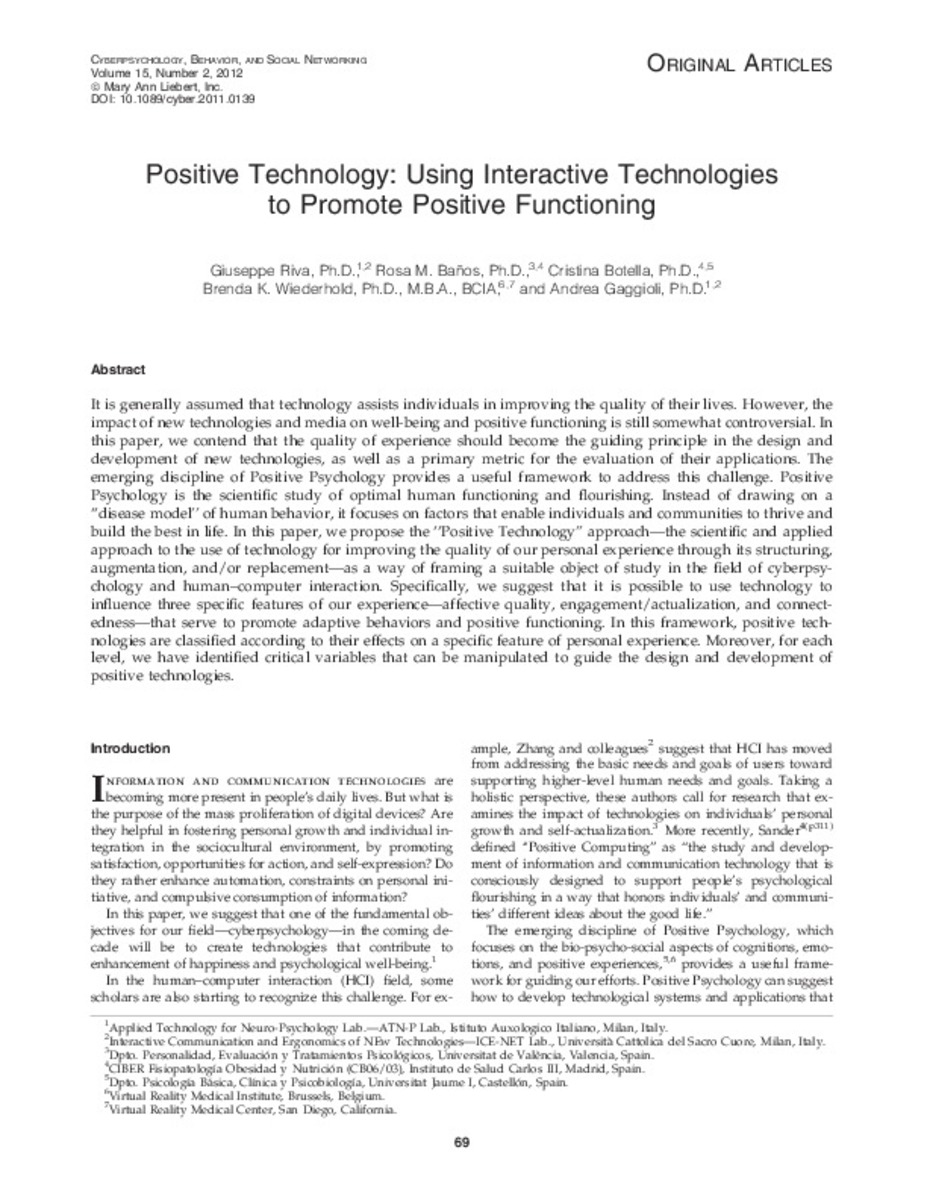Mostrar el registro sencillo del ítem
Positive Technology: Using Interactive Technologies to Promote Positive Functioning
| dc.contributor.author | Riva, Giuseppe | |
| dc.contributor.author | Baños, Rosa Maria | |
| dc.contributor.author | Botella, Cristina | |
| dc.contributor.author | Wiederhold, Brenda K. | |
| dc.contributor.author | Gaggioli, Andrea | |
| dc.date.accessioned | 2014-04-03T14:15:25Z | |
| dc.date.available | 2014-04-03T14:15:25Z | |
| dc.date.issued | 2012 | |
| dc.identifier.issn | 2152-2715 | |
| dc.identifier.issn | 2152-2723 | |
| dc.identifier.uri | http://hdl.handle.net/10234/89392 | |
| dc.description.abstract | It is generally assumed that technology assists individuals in improving the quality of their lives. However, the impact of new technologies and media on well-being and positive functioning is still somewhat controversial. In this paper, we contend that the quality of experience should become the guiding principle in the design and development of new technologies, as well as a primary metric for the evaluation of their applications. The emerging discipline of Positive Psychology provides a useful framework to address this challenge. Positive Psychology is the scientific study of optimal human functioning and flourishing. Instead of drawing on a ‘‘disease model’’ of human behavior, it focuses on factors that enable individuals and communities to thrive and build the best in life. In this paper, we propose the ‘‘Positive Technology’’ approach—the scientific and applied approach to the use of technology for improving the quality of our personal experience through its structuring, augmentation, and/or replacement—as a way of framing a suitable object of study in the field of cyberpsychology and human–computer interaction. Specifically, we suggest that it is possible to use technology to influence three specific features of our experience—affective quality, engagement/actualization, and connectedness— that serve to promote adaptive behaviors and positive functioning. In this framework, positive technologies are classified according to their effects on a specific feature of personal experience. Moreover, for each level, we have identified critical variables that can be manipulated to guide the design and development of positive technologies | ca_CA |
| dc.format.extent | 9 p. | ca_CA |
| dc.format.mimetype | application/pdf | ca_CA |
| dc.language.iso | eng | ca_CA |
| dc.publisher | Mary Ann Liebert | ca_CA |
| dc.relation.isPartOf | Cyberpsychology, Behavior, and Social Networking, 2013, Vol. 15, núm. 2 | ca_CA |
| dc.rights | ©Mary Ann Liebert, Inc. This is a copy of an article published in the Cyberpsychology, Behavior, and Social Networking © 2012 copyright Mary Ann Liebert, Inc.; Cyberpsychology, Behavior, and Social Networking is available online at: http://online.liebertpub.com | ca_CA |
| dc.rights.uri | http://rightsstatements.org/vocab/InC/1.0/ | * |
| dc.subject | Positive technology | ca_CA |
| dc.title | Positive Technology: Using Interactive Technologies to Promote Positive Functioning | ca_CA |
| dc.type | info:eu-repo/semantics/article | ca_CA |
| dc.identifier.doi | http://dx.doi.org/1089/cyber.2011.0139 | |
| dc.rights.accessRights | info:eu-repo/semantics/openAccess | ca_CA |
| dc.relation.publisherVersion | http://online.liebertpub.com/loi/CYBER | ca_CA |
| dc.type.version | info:eu-repo/semantics/publishedVersion | ca_CA |
Ficheros en el ítem
Este ítem aparece en la(s) siguiente(s) colección(ones)
-
PSB_Articles [1294]
Articles de publicacions periòdiques







